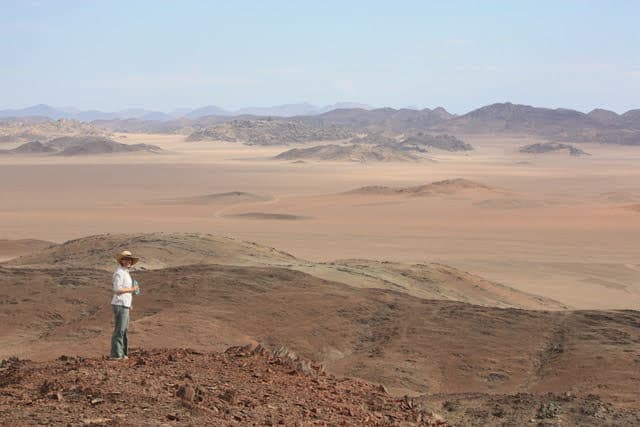
The Ultimate Roadtrip to Namibia’s Farthest Corner
By Melinda Burrell
Driving in Namibia is addictive. It’s the second least densely populated country on the planet, so you can drive for hours without seeing anotherhuman. What you will see, as German geologist Henno Martin said, is “the skeleton of the earth exposed.”
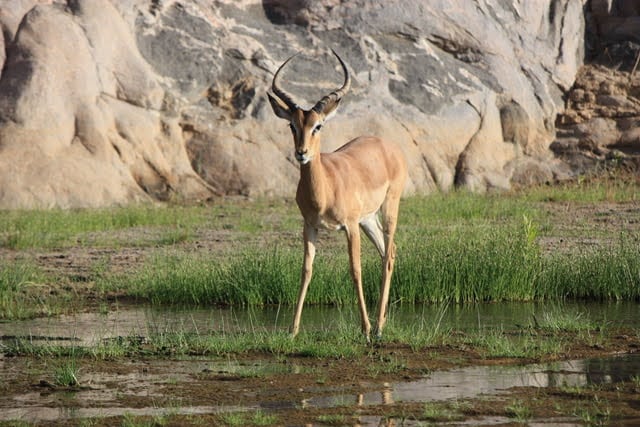
And it leaves you breathless: tall, red dunes jutting against blue skies in the Namib desert; milk-white dunes plunging into the Atlantic; orange granite formations writhing out of the central plains.
Namibian driving rules
You quickly learn the rules. A 4×4 is essential, preferably in sun-reflecting white, like seemingly all Namibian vehicles. Bring water, extra water, and then some more.
Prepare for tire blowouts on the ubiquitous gravel roads. Never, ever pass a gas station without filling up. The next one may be hundreds of miles away.
My husband and I were excited for a 10-day vacation in remote, northern Namibia. We also were a bit nervous about our timing – early December and the hot, teasing start of the rainy season.
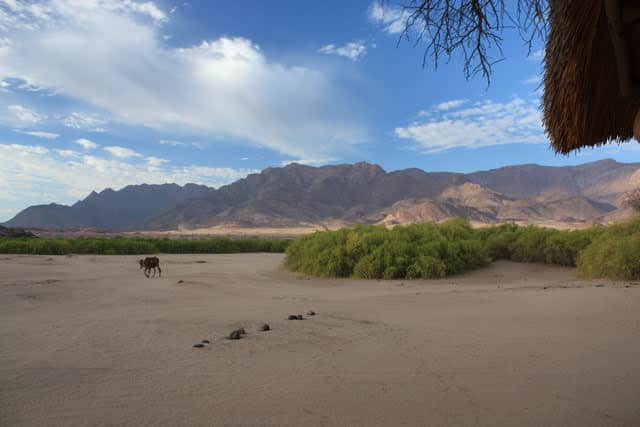
Starting with Namibia’s tallest mountain
December 1st found us heading from the capital city of Windhoek toward Brandberg, Namibia’s tallest mountain. An 8500-foot-tall pile of granite, Brandberg stands alone at the edge of the Namib desert. As we neared the mountain, we thrilled to the scenery – red and grey masses of granite and basalt thrusting up out of white sand into the blue, blue sky.
 But as we got close to our destination, the Brandberg White Lady Lodge, we grew alarmed. The temperature shot up 5 degrees in 10 minutes, topping out at 101 as we pulled up to our lodge-without-air conditioning.
But as we got close to our destination, the Brandberg White Lady Lodge, we grew alarmed. The temperature shot up 5 degrees in 10 minutes, topping out at 101 as we pulled up to our lodge-without-air conditioning.
Happily, as the sun dipped lower, a cooling breeze arose. Soon we were sipping a chilled chenin on our chalet porch. Thunderheads formed on the horizon. Spurfowl squawked. A skinny cow ambled by. Brandberg’s folded, craggy mass shone above us in the setting sun.
Brandberg is home to desert elephants, which are occasionally aggressive. Though we longed to stretch legs cramped from the drive, we heeded lodge warnings and drove the several hundred yards across a sandy flat to the restaurant.
A good meal gave way to a long, hot night of mosquito bites – our hut’s ventilation let in the bugs but not the breeze – but the early morning promised an adventurous game drive in the lodge’s large, open-backed truck.
Staring down desert-adapted elephants 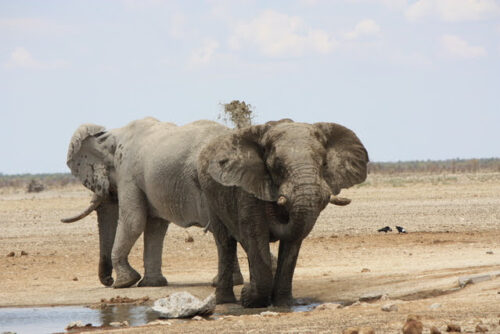
Sure enough, within moments we spied dinner plate-sized elephant footprints in the dry riverbeds. Older elephant tracks are smooth while recent ones still show distinctive ridges. Looking for crinkles, we followed a collection of tracks down riverbeds, over hills, through acacia stands. Finally, our guides spotted five females.
Life at the edge of the Namib makes desert-adapted elephants smaller and thinner than luckier savannah cousins. Small but tough, they can go without water for several days. We watched a small one – only the size of an SUV – curl her trunk expertly around a thorn bush to rip off the few edible leaves.
Then she noticed us. She extended her ears wide, stepping closer. “You’re safe,” our guide whispered. “But don’t move.”
 I froze. She stopped, four feet from our open vehicle. I could trace the different course of each coarse eyelash. She flapped her ears and squinted at us. To be even stiller, I slowed my breathing.
I froze. She stopped, four feet from our open vehicle. I could trace the different course of each coarse eyelash. She flapped her ears and squinted at us. To be even stiller, I slowed my breathing.
Suddenly she whipped her trunk and knocked our side-view mirror. Thunk! Satisfied, she backed off and resumed stripping bushes. In turn, we resumed our drive back to the lodge. An adventure we had had.
Meeting the White Lady – and her animal guards
After lunch, we drove to the foot of the Brandberg itself. A 45-minute sandy trek took us to a shallow cave featuring 2,000-year-old rock paintings. Oryx pranced on human hind legs, people danced in trances. The famous White Lady, damaged by decades of tourists spraying Coke to bring out its colors, gleamed faintly.
Pondering what we’d seen, we began our descent. A ruckus arose in the rocks. Ten baboons were encroaching on territory we’d earlier seen held by woodchuck-like rock dassies. The baboons barked aggressively, incensing the dassies. The dassies howled their rage. Their ricocheting shrieks followed us to the end of the trail.
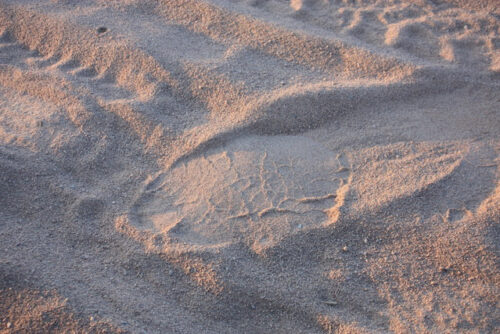
Roadside companions
The next day launched Stage Two of our journey, north along sand and gravel back roads. An ostrich darted across the road in front of us, then turned to run alongside the road. We clocked his speed — 25 mph and it didn’t even look like high gear. Grey storm clouds played about the edges of the valley, threatening but not delivering rain. At least their shadow cooled the plain.
After a few hours, we emerged into the outer edges of human habitation where Damaraland and the Kaokoland meet. We drove through the small, dusty town of Sesfontein, glimpsing three Herero women in traditional dress. Influenced by Namibia’s years as a German colony, Herero women wear full-length Victorian dresses with matching hats reminiscent of cow-horns. The three were sipping Saturday afternoon beers on stools outside a shebeen.
Past Sesfontein we entered a long sandy valley. Sheets of rock rose out of the earth to rim it, like a rough sea frozen into stone – more of the earth’s exposed skeleton. Giraffe drooped under acacia trees. Dark, lightning-streaked clouds piled up behind the mountains, seeking release.

Arriving in Purros, Namibia
We arrived in the small town of Purros, with its scores of widely-spaced tin shacks, silent and melting in the 4 pm heat. Handmade cardboard signs indicating a track to our lodge led us across the deep sands of the dry Hoarusib riverbed. These we nervously navigated, finding relief in the hard ground of the opposite bank and a ridge leading to a series of ochre chalets overlooking the mountains and approaching storm: Okahirongo Lodge.
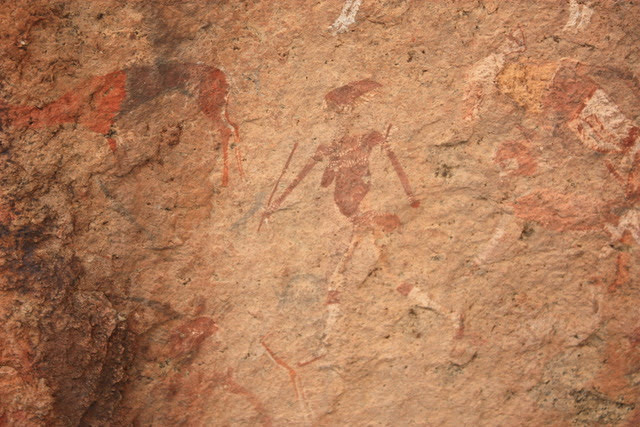
A Namibian oasis
The next morning’s game drive gave us a glimpse of what a geology book charmingly describes as “the wetter times” of Namibia’s past. Though most of Namibia is unrelentingly arid, hard rock undergirding the riverbed forces water to the surface where the Hoarusib cuts through the mountains in search of the Atlantic. We reveled in the slightly fetid smell of reeds and the six shades of unaccustomed green brightening the lowest meter of the flinty canyon: fluffy tamarisks, arched makalani palms, and bushy mopane trees.
“These are tracks of elephants pushing downstream,” our guide pointed to large round indentations. He sucked in his breath as he glimpsed another set of prints. “A large male lion.” Fresh, inch-deep in the wet sand, twice the size of a large man’s fist – we could understand his consternation. “This is a lone lion. But I think it’s one that used to travel here with his brothers.”
Tom and I looked at each other in horror. We’d just watched “The Vanishing Kings,” an excellent documentary about Namibia’s dwindling desert-adapted lions. We realized these were the prints of the only one of the five brothers – the Kings of the film – still alive. The other four had been killed earlier that year by farmers protecting their livestock. “Purros residents know not to kill this lion,” our guide added. “But there is always a risk with the nomadic herders.”
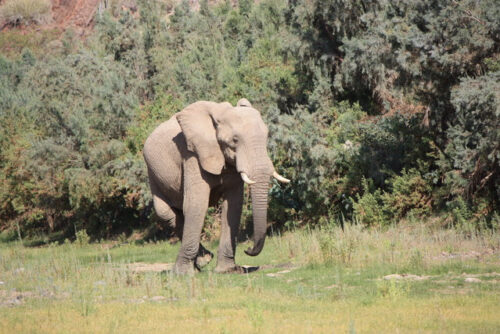
Elephants Digging for Water
We found the elephants at last and watched them dig for water, nurse a 4-month-old baby, and stretch trunks to eat dangling weaverbird nests. We never did see the lion that worried the guide. Instead, back at the lodge, we lounged in the pool to evade the heat.
From our porch later that evening, we watched a wind battle waged high above. It was a fierce fight typical of the start of the rainy season. Warm, dark, flashing storms from inland were pushed back by strong cold winds off the nearby Atlantic. Watching that mile-high clash, we could see why it hadn’t rained in Purros in three years.
Experiencing Namibia’s Skeleton Coast
The next day we went to the source of those cold winds, to the edge of the Skeleton Coast National Park. Fresh sea breezes fought the furnace of the desert morning – 95 degrees at 9:30. Through binoculars from a high peak, we inspected the sandy, rocky, yellow, red, brown, purple landscape – all desolation and dryness. Isolated oryx galloped across nothingness, wind-whipped rock walls, a dust trail boiled behind a lone 4×4 in the distance.
That evening our guide drove us up the nearby hills, a brown and tan version of the morning’s colorful dryness. In zebra wallows we found white and black tail hairs. I pocketed one, charmed to have a memento of one of my favorite animals.
A bit further on, our guide had us get out again. “My father herded cattle. You see here, where two game trails come together? He taught me to look for these arrows. They lead to water.”
Back in the jeep, we bumped past an abandoned Himba nomadic camp, with the saplings still lashed together where domed huts had stood. Its simplicity and proximity to animals spoke volumes about human-wildlife conflict. Soon after, we stopped on a hillside for the obligatory game drive gin and tonic under a spectacular sunset.
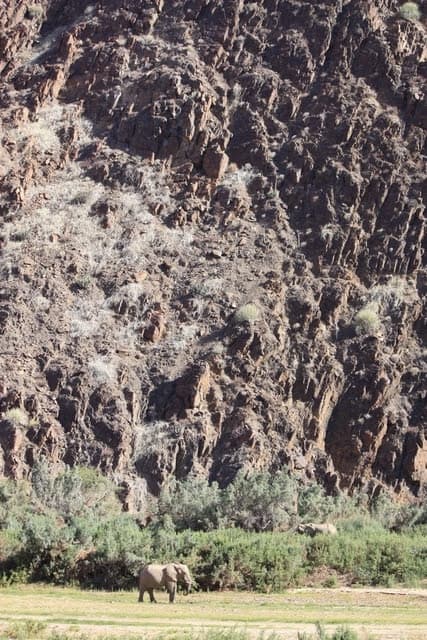
Settling into Etosha National Park
The next morning began the third stage of our trip, a long but magnificent drive from Purros to Etosha National Park. Namibia’s oldest and largest game reserve, much of it surrounding a prehistoric lakebed, Etosha is nearly as large as New Jersey.
When we reached the western entrance to the park at the Galton Gate, a lanky guard apologetically searched our car for firearms. “The road is not fine,” he cautioned as he released us. Though we did jounce uncomfortably over the 25 miles to our lodge, glimpses of passing impala, giraffe, zebra and steenbok softened the jolts.
Our lodge was a series of luxurious permanent tents clinging to a rocky ridge overlooking a plain of camelthorn acacias. Though staff warned us that the lodge was not fenced from animals and therefore we should not walk alone after dark, they were all talk and no escort action.
Happily, we didn’t see the large femur something had left on the slope near our tent until we’d successfully navigated ourselves home from dinner.
Communing with Elephants
We hopped into our car excitedly the next morning and headed for the Olifantstrus campsite. Etosha campsites are reverse zoos: the people stay inside an enclosure and the animals circulate freely outside. Olifantsrus had a two-story lookout over an elephant watering hole, the lower windows of which were obscured by trunk smudges.
Though no elephants at that moment, there was a well-done exhibit with the grim information that Olifantstrus had been the culling site for 525 elephants during the 1980-1983 drought. The rain had already come to parts of Etosha this season, so we hoped more such action would not be required.
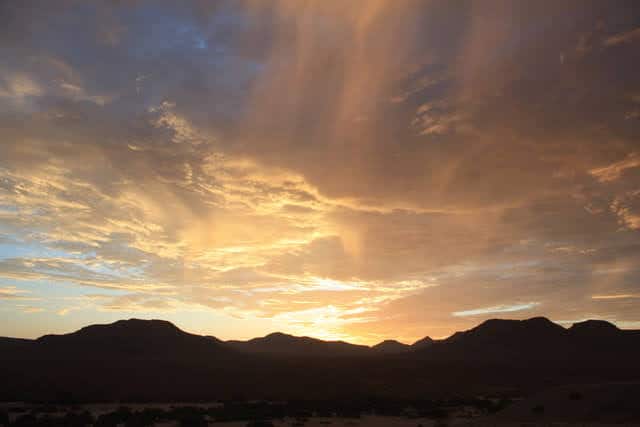
After Olifanstrus, we had luck with watering holes – zebras and warthogs rolling indulgently in the mud; days-old, moose-shaped hartebeests tripping over their own long legs as they tried to keep up with Mom; three old bull elephants dozing in the heat, long trunks slumped on the ground, water dribbling down bristly chins, occasionally shooting mud over themselves to cool off. Wrinkly grey hides drooped below their knees, for all the world like saggy socks.
As we left that hole, we spotted a big bull elephant about fifty meters from the road, meandering in search of the 70 pounds of food he needs to eat every day.
Seeing us, he charged, trunk lifted in full trumpet while we shot ahead out of his way. Satisfied, he slowed. In our rearview mirror, we saw him resume plodding, his bulk taking up almost the entire width of the road.
Bidding farewell
Leaving Etosha the next morning, a corkscrew-horned kudu leaped out of the bushes beside the road. Tom swerved, skidded on the gravel, and missed by inches its 600 pounds. As our heartbeats slowed, we listened to a radio announcement that poachers were on the loose after a shootout the day before with park police. Perhaps this was a good time to leave.
Back on the paved road, vans were dragging north, filled with people going home to their villages for the start of the holidays. As for us, we’d survived the hot start of the rainy season. It was time to head back to Windhoek for some air conditioning.
 Melinda Burrell is a humanitarian aid worker who currently writes and trains on conflict and communication. She has published academic articles and a book chapter (Rowman and Littlefield, 2020) and is a newly syndicated opinion piece writer for PeaceVoice with articles appearing in local newspapers around the U.S. She lives in Washington DC.
Melinda Burrell is a humanitarian aid worker who currently writes and trains on conflict and communication. She has published academic articles and a book chapter (Rowman and Littlefield, 2020) and is a newly syndicated opinion piece writer for PeaceVoice with articles appearing in local newspapers around the U.S. She lives in Washington DC.
- Camino Tales: Wine and Memories in Galicia, Spain - July 25, 2024
- Beluga Hunting in Norway - July 20, 2024
- Costa Rica: A Rainforest Chocolate Tour - July 18, 2024




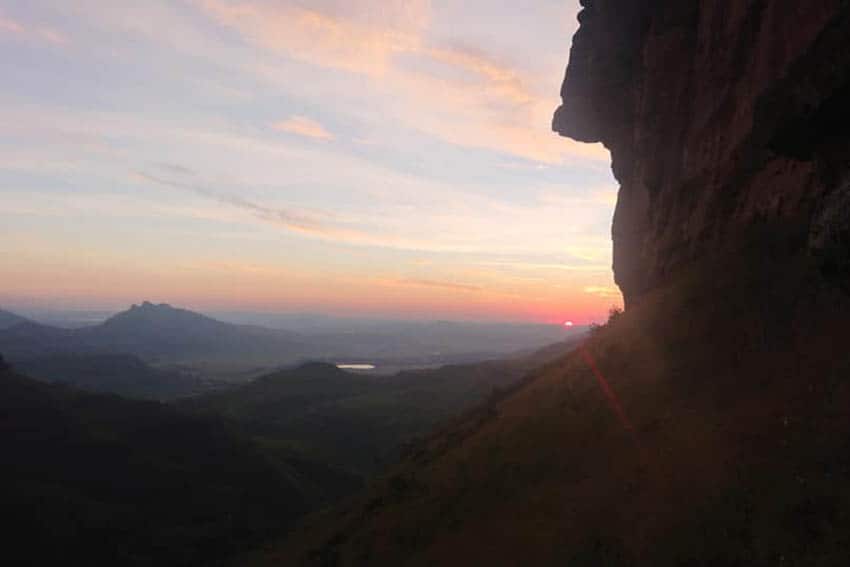

http://etosha-app.com/ – Etosha App is an amazing pocket guide which helps you out with Mammal Guide, Offline Navigation and much more.